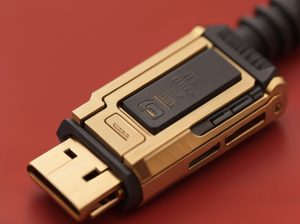
Flash memory is a type of solid-state semiconductor energy-dependent memory that can be rewritten by the user.
How flash memory works
The main function of flash memory is to store information that is located in an array of “cells,” each of which can hold one, sometimes more, bits of data.
In turn, a cell is a transistor that has two isolated gates. One of them is the controlling one, and the other is the “floating” one, which holds electrons, i.e., the charge.
One of the components of the cell is electrodes: “sink” and “source”. When the programming process takes place, a channel called the “electron flow” is formed between them under the influence of a positive field on the control gate. Some of the electrons that have more energy overcome the insulator layer and move to the “floating” gate, where they are stored for several years.
A certain range of the number of electrons on this gate corresponds to a logical one, but anything greater than that corresponds to zero.
During the reading process, these states are recognized by measuring the transistor’s threshold voltage.
When you need to erase information, a negative voltage increased several times is applied to the control gate, and electrons move from the “floating” gate to the source.
Today, there are two main types of flash memory: NOR flash and NAND flash, which use the same cell structure, but have a number of functional differences.
- NOR flash
This type of memory is characterized by high random access speed. The user can access the cells one by one, since each cell has a separate conductor. However, this imposes certain restrictions on the maximum amount of memory per unit area.
There are two types of NOR flash memory:
Serial NOR, which is known as SPI NOR. It has sections and pages, where sections are larger than pages. A sector is a block of memory where all data can be erased, and once while other data is being written to the pages.
Parallel NOR – here the memory controller accesses memory using a parallel address bus.
Characteristics of NOR flash:
- non-volatility – storage devices that have flash memory of this type can store information data without using a battery or any other power source.
- fast readout – the time required to read the stored data is much shorter, which is why NOR is often used in a variety of applications.
- random access interface – that is, the user can address a part of the memory instead of reading it sequentially from the very beginning.
- dense memory – this means that a small chip can store a large amount of data, but it is not produced for sale
NOR flash is used:
- scientific instruments;
- cell phones;
- as a statistical random access memory SRAM;
- devices using the “make in place” method.
This type of memory has
a number of advantages
that you need to know, namely:
- NOR flash is solid-state, so it is resistant to various types of damage, such as shocks or scratches;
- Reading time is very fast;
- can be manufactured in the form of small integrated circuits;
- energy-independent;
- It has a shelf life of up to 10 years;
- is suitable for a RAM storage device;
- is best suited for implementing “on-site execution” technology.
- NAND FLASH
If we’re talking about this type of memory, you should know that cells are grouped into small blocks, so reading and writing is possible only in whole blocks. All modern file-oriented flash drives use it.
There are several types of NAND flash, namely:
- SLC is an abbreviation for single-level cell. It’s an old guy. Because each cell can represent only one binary digit.
- An MLC is a multi-level cell that can represent 2 bits, but their lifetime is shorter because there are several times more write and rewrite cycles.
- TCCs are three-level cells, meaning that each cell stores 3 bits of memory, which allows you to store more data on the same area.
- A cell is a four-level cell.
- 2D NAND – here the cells are arranged horizontally, creating a two-dimensional matrix.
- 3D NAND – here, the cells are arranged vertically, creating a three-dimensional matrix that saves space and also allows you to increase the amount of memory by reducing the size of the chip.
Characteristics of NAND flash:
- non-volatility – this means that devices using this type of memory store data without using a battery or any other voltage source;
- has the ability to be reprogrammed, meaning that the user can reprogram it to meet their needs;
- faster data recording and erasing;
- has more space for storing information – this type of memory is so dense that a user can purchase a device with a 2TB capacity;
- low production costs.
Most often, NAND flash is used in:
- SSD;
- USB flash drives;
- memory cards;
- digital cameras;
- audio players and set-top boxes.
The main advantages of NAND flash include:
- This type of memory is solid-state, which means it will work even after an accidental drop;
- devices that use this type of memory can store information up to 2 TB;
- can be created in the form of small-sized and high-capacity chips;
- works best when it comes to extreme use.
So, modern devices can use either one type of memory, or some systems will use a combination of NOR and NAND memory, where the smaller NOR memory is used as a program ROM and the larger NAND memory is partitioned by the file system to store different information.

